The key to these biscuits is the use of lard. I use leaf lard rendered from the kidney fat of pasture raised Berkshire pigs. The lard is unhydrogenated and has no additives and features a clean, almost sweet, taste. Frying with this lard and making pastries with it adds a delicate, pleasant flavor that the supermarket lard (in my area the only brands available are Armour and Farmer John which are both partially hydrogenated and taste very "porky") just cannot match. If high quality lard isn't available in your area, I recommend substituting the lard in this recipe with butter. The biscuits will be a little chewier, but the butter flavor will be more pronounced (but will lack the subtle flavors that lard contributes). I'm not a fan of using vegetable shortening even though the texture will be better than using all-butter, because it contributes no flavor.
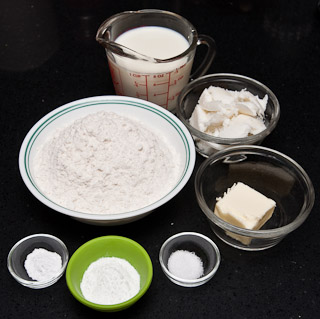 The ingredients are simple: 2 cups (280 g) all-purpose flour, 1 cup (235 mL) buttermilk, 2 ounces (55 g) leaf lard, 2 tablespoons (28 g) unsalted butter, 1/2 teaspoon (3 g) table salt, 4 teaspoons (18 g) baking powder, and 1/2 teaspoon (2.3 g) baking soda.
The ingredients are simple: 2 cups (280 g) all-purpose flour, 1 cup (235 mL) buttermilk, 2 ounces (55 g) leaf lard, 2 tablespoons (28 g) unsalted butter, 1/2 teaspoon (3 g) table salt, 4 teaspoons (18 g) baking powder, and 1/2 teaspoon (2.3 g) baking soda.Related Articles
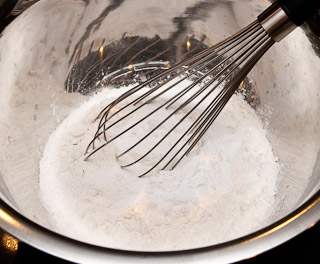 In a mixing bowl, mix the flour, baking powder, baking soda, and salt together until well combined.
In a mixing bowl, mix the flour, baking powder, baking soda, and salt together until well combined.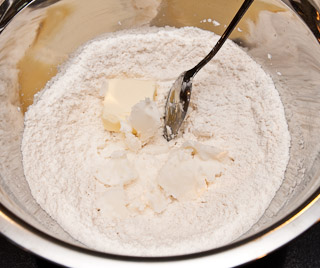 Add the butter and lard to the flour and cut it in until only pea-sized or smaller clumps are visible.
Add the butter and lard to the flour and cut it in until only pea-sized or smaller clumps are visible.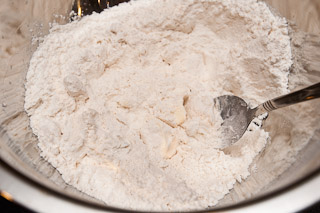 I accomplish this by tossing the flour around the fats until they are fully coated. Then I start to cut and press them using a spoon or knife. While cutting, I stir to keep the pieces coated with flour.
I accomplish this by tossing the flour around the fats until they are fully coated. Then I start to cut and press them using a spoon or knife. While cutting, I stir to keep the pieces coated with flour.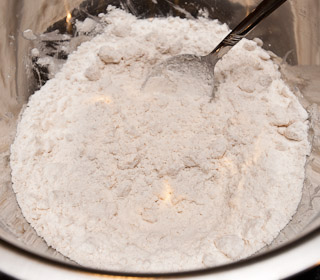 Here's what it looks like when the fats have been cut to the proper size.
Here's what it looks like when the fats have been cut to the proper size.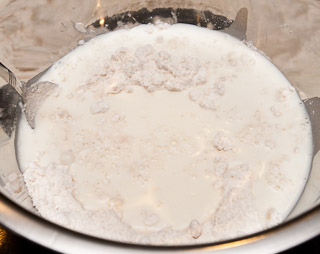 Pour the milk into the flour mixture.
Pour the milk into the flour mixture.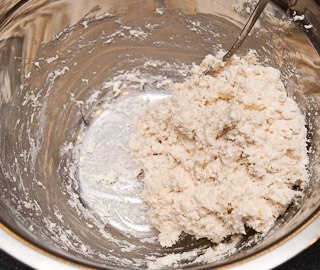 Stir with a spoon just until all the flour is wet and it starts to clump together.
Stir with a spoon just until all the flour is wet and it starts to clump together.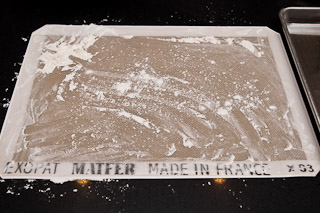 Prepare a surface for rolling out the dough. I prefer a silicone baking mat that has been dusted with flour. This is also a good time to preheat the oven to 450°F (230°C).
Prepare a surface for rolling out the dough. I prefer a silicone baking mat that has been dusted with flour. This is also a good time to preheat the oven to 450°F (230°C).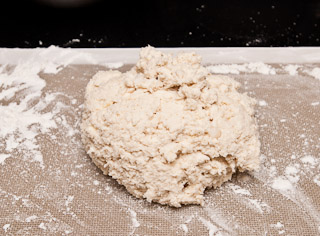 Roll the dough from the mixing bowl onto the floured surface.
Roll the dough from the mixing bowl onto the floured surface. Dust your hands with flour and sprinkle flour on the exposed surface of the dough (which will be quite tacky at this point). Covering the hands with flour and dusting the dough will make it easier to work with. Don't be afraid to continue adding flour to the surface of the dough if it gets tacky to the touch.
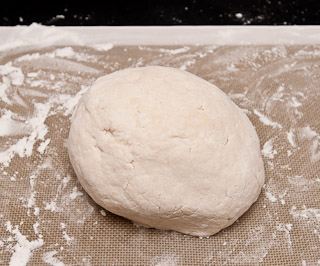 Without overworking the dough, form/roll it into a ball. Roll it over and flour the bottom if it is tacky.
Without overworking the dough, form/roll it into a ball. Roll it over and flour the bottom if it is tacky. Use a rolling pin to roll out the dough into a large rectangular shape. Lightly dust the surface with flour.
Use a rolling pin to roll out the dough into a large rectangular shape. Lightly dust the surface with flour. Fold the dough in thirds over itself and lightly dust. (This is like folding a letter twice to fit into a letter sized envelope; some people refer to this as a business envelope fold.)
Fold the dough in thirds over itself and lightly dust. (This is like folding a letter twice to fit into a letter sized envelope; some people refer to this as a business envelope fold.)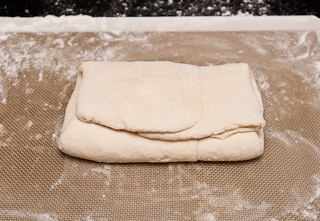 Fold the dough in thirds in the other direction (perpendicular to the direction of the previous folds).
Fold the dough in thirds in the other direction (perpendicular to the direction of the previous folds).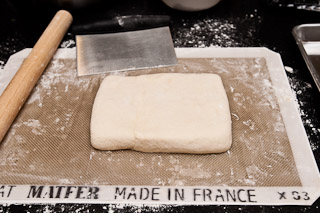 Press and shape the dough into a rectangle about 1 inch (25 mm) think.
Press and shape the dough into a rectangle about 1 inch (25 mm) think.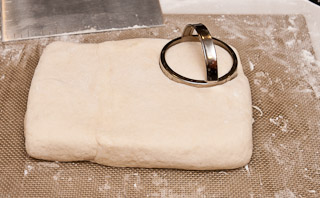 Using biscuit cutters, cut rounds out of the dough. Make sure each round has a circumference that is cut dough (that is, we want to make sure the cutter actually presses through the dough on all sides; an uncut edge won't rise as well as a cut edge, so we want to make sure the whole circlue is cut). Pressing straight down with the biscuit cutter helps make clean cuts which allow for even rising. If you twist/rotate the cutter while pressing down, that can cause the edge of the biscuit dough to "pinch" on itself which inhibits rising on the edges (and thus less overall rise). If you don't have biscuit cutters, cut the dough into squares with a sharp knife after trimming the edges off (the edges won't rise easily).
Using biscuit cutters, cut rounds out of the dough. Make sure each round has a circumference that is cut dough (that is, we want to make sure the cutter actually presses through the dough on all sides; an uncut edge won't rise as well as a cut edge, so we want to make sure the whole circlue is cut). Pressing straight down with the biscuit cutter helps make clean cuts which allow for even rising. If you twist/rotate the cutter while pressing down, that can cause the edge of the biscuit dough to "pinch" on itself which inhibits rising on the edges (and thus less overall rise). If you don't have biscuit cutters, cut the dough into squares with a sharp knife after trimming the edges off (the edges won't rise easily).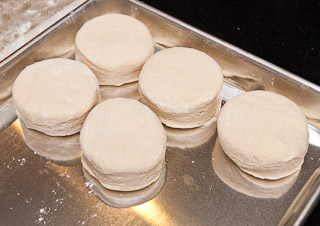 As you cut biscuits, place them directly on a baking sheet pan. Place them close together, either just touching or about to touch. If they touch, it will help them rise but you'll need to pull them apart after they've been baked.
As you cut biscuits, place them directly on a baking sheet pan. Place them close together, either just touching or about to touch. If they touch, it will help them rise but you'll need to pull them apart after they've been baked.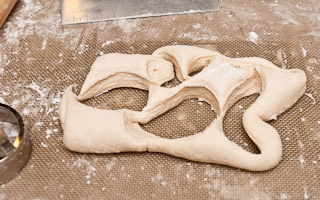 Scraps left over from the cuts can be pressed together and rerolled to make more biscuits, but these biscuits will be denser than the first group.
Scraps left over from the cuts can be pressed together and rerolled to make more biscuits, but these biscuits will be denser than the first group.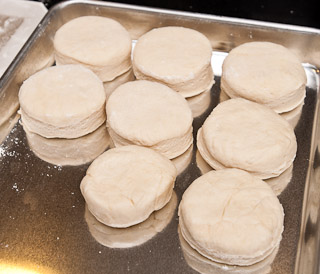 Continue to line you baking pan until you've used all the dough. With my large biscuit cutters and this recipe, I make eight biscuits.
Continue to line you baking pan until you've used all the dough. With my large biscuit cutters and this recipe, I make eight biscuits.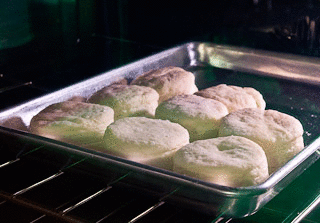 Bake at 450°F (230°C) until risen and golden brown - about 15 minutes.
Bake at 450°F (230°C) until risen and golden brown - about 15 minutes.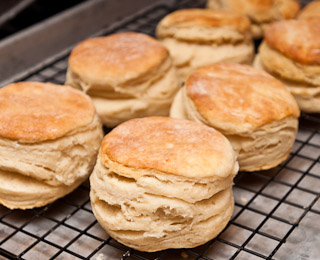 Remove the biscuits from the baking pan and place on a wire rack to cool. This prevents the bottoms from getting soggy as they cool. (In a pan, moisture from the steam begins to condense. On wire rack, the moisture from the steam can freely escape from the bottom of the biscuit into the air.)
Remove the biscuits from the baking pan and place on a wire rack to cool. This prevents the bottoms from getting soggy as they cool. (In a pan, moisture from the steam begins to condense. On wire rack, the moisture from the steam can freely escape from the bottom of the biscuit into the air.) Serve while warm or at room temperature.
Serve while warm or at room temperature.Southern Buttermilk Biscuits (makes approximately 8 large biscuits)
| Preheat oven to 450°F (230°C) | ||||||||||
| 2 cups (280 g) all-purpose flour | mix | cut in until pea sized | mix | dust with flour and roll into ball | roll into large rectangle, dust, and envelope fold | envelope fold other direction | press into 1-in thick block | cut and arrange on baking sheet pan | bake 450°F (230°C) 15 min. | cool on wire rack |
| 4 tsp (18 g) baking powder | ||||||||||
| 1/2 tsp (2.3 g) baking soda | ||||||||||
| 1/2 tsp (3 g) table salt | ||||||||||
| 2 Tbs (28 g) unsalted butter | ||||||||||
| 2 oz (55 g) leaf lard | ||||||||||
| 1 cup (235 mL) buttermilk | ||||||||||
Related Articles

The recipe is called "Southern Buttermilk Biscuits" to differentiate them from the hard cookies also called biscuits or certain types of crackers of the same name.
I struggled with the volumetric measurement of flour for this recipe (as I do with all my baking recipes). The correct amount of flour to use is 280 g, but what volume do I provide for readers without a scale and rely on measuring cups? In my experience, a bag of flour that has been sitting in the pantry can range in density from 150 g per cup to 185 g per cup (it can be more if you lightly tap the flour bag against the counter over and over to compress the flour). Freshly sifted flour can weigh 125 g per cup or less (125 g is the official USDA mass for 1 cup of all-purpose flour). In theory, one should use the 125 g per cup measurement because that's the only non-variable when it comes to flour. If you sift the flour well (let's say three times), then scoop your dry measuring cup into the flour and level it, it will be very close to 125 g. However, it's not reasonable to assume that the home cook will freshly sift their flour every time a recipe calls for flour. What do people do? They grab their bag of flour, scoop the measuring cup in, and level it. More often than not, when I do that, it comes in at around 160 g per cup. So, on several recipes I use that measurement. Initially, when I wrote this recipe, I based it on the 160g per cup measurement (so I had 1-3/4 cup flour), but while researching baking recipes I keep finding authors using 5 oz per cup as the conversion: 140 g per cup of flour. I found that I could get 140 g in a cup if I first used the measuring spoon to loosen up the flour (scoop, drop, scoop, drop, stir) and then scoop, level, and measure. Sifting results in too little flour per cup, not doing anything results in too much flour per cup, but playing with the flour first seems just right. So, this recipe uses the 140 g per cup conversion factor.
If you're in the Austin area and looking for an excellent source for leaf lard made from local pastured pork, try Dai Due. Jesse Griffiths renders the pork fat from Richardson Farms hogs.
Sometimes calling local pastry shops or butchers can reveal sources to local leaf lard sellers or renderers.
I'm also moving the old biscuits recipe from the Recipe File to Test Recipes.
Yes, just use 6 tablespoons (3 ounces) of butter instead of the lard and butter combination.
Boccalone (Chris Cosentino's salumeria) in the Ferry Building stocks rendered pig fat regularly at $10 for one pound. I just called and it isn't pure leaf lard; the lard is rendered from the fat of all different parts of the hog, but it might be good enough. Just don't use the supermarket stuff - it's nasty tasting and probably contains trans fats.
They did tell me that Prather Ranch (the meat guys also in the Ferry Building) occasionally stocks pure leaf lard, but it's probably something you'll need to call ahead and ask about since it's only once in a while that they have it.
That was five or six years ago, so I don't know if he's still in business.
My large biscuit cutter is 3-in (75 mm) in diameter. The first rolled layer (the thin one that I roll out completely before the two business envelope folds) is about 11-in x 16-in (280 mm x 405 mm).
Yep.
Is the pastry blender the tool that looks like a handle with four or five half circle wires or metal strips looping out of it? It might be mine, but I find that I'm faster with a spoon than my pastry cutter. I also find the two knives technique a bit awkward, but I also haven't had much practice with it.
It cost $39.00/5# plus shipping. The surprise was that the leaf lard was the unrendered lard. So, I have now learned how to render lard! It was actually very easy (low and slow) in my crockpot. I now have lots of snowy white leaf lard to make biscuits, pie crust, etc. Since I was paying shipping anyway, I ordered their Berkshire pork chops. So now I am in heaven.
Michael turned me onto leaf lard for pie crust. It's wonderful stuff.
It's quite a bit cheaper to make at home if your butcher can get it.
See my note here
http://www.cookingforengineers.com/forums/viewtopic.php?p=22694#22694
I love your site and full proof formulas. Question? Is there anyway you could create a similar formula for a Southern Sweet potato buttermilk biscuit?
I've never had a Southern Sweet Potato Buttermilk Biscuit! But, it sounds awesome. I'll keep my eyes open for a good recipe to try, but I wouldn't know if it came out right since I've never had one... (of course, that doesn't mean I won't know if it's bad :) )